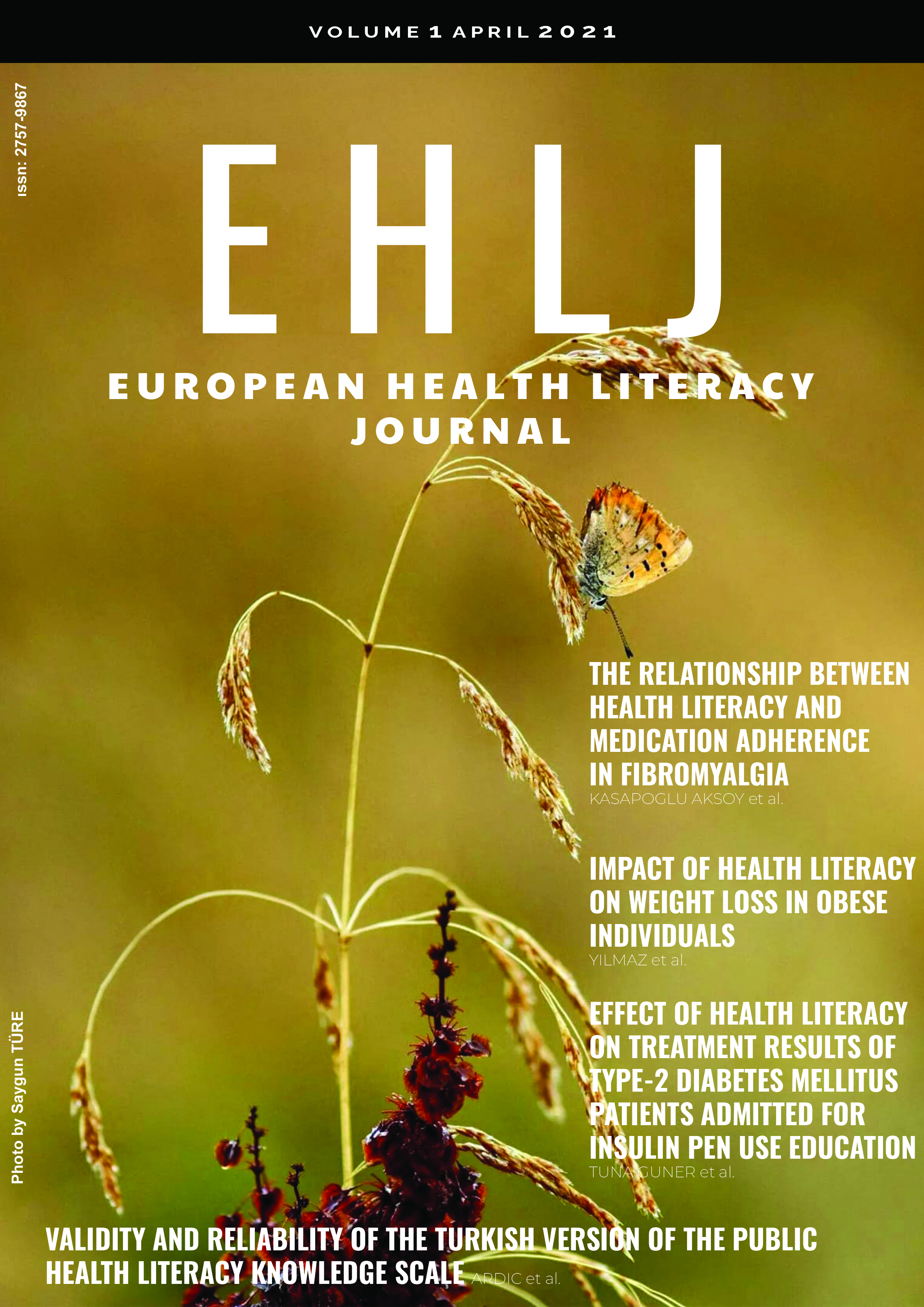Author :
Abstract
Keywords
Abstract
Aim: To translate the "Public Health Literacy Knowledge Scale" questionnaire developed by Pleasant and Kuruvilla into Turkish, to investigate the validity and reliability of the Turkish questionnaire.
Methods: The necessary permissions have been obtained. The translation of the English form into Turkish was carried out in two steps. Sampling of 290 people was deemed sufficient. In evaluating the reliability of the scale (Test-retest method), the relationship between the Turkish and English forms of the scale was analyzed with correlation analysis in line with the answers received from 40 undergraduate students. The content validity of the scale was evaluated with the Newest Vital Signs scale.
Results: English and Turkish forms were found to have a high level of positive correlation in the language equivalence study of the scale. A significant relationship between the Public Health Literacy Knowledge scale and the total scale scores of the Newest Vital Sign scales has been determined in the same direction and it has been assumed that the Public Health Literacy Knowledge scale provides the validity of the criteria. When the scale reliability was examined in terms of internal consistency, the Cronbach alpha coefficient of the Public Health Literacy Knowledge scale was found to be α=0.58. Looking at the Cronbach Alpha coefficient, it seems that this scale is a poor measurement tool in terms of internal consistency. In a reliability study by Test-retest method, the Public Health Literacy Knowledge scale was re-applied to a group of 40 people three weeks after the first application, and the test-retest correlation was found to be rs=0.93 (p<0.001).
Conclusions: The Turkish validity of the Public Health Literacy Knowledge Scale was provided in this study. The internal consistency of the scale is poor, but its reliability can be evaluated as excellent.
Keywords
- 1. https://www.unicef.org/publications/files/Facts_f or_Life_EN_010810.pdf Access Date: 06.02.2020.
- 2. Pleasant A, Kuruvilla SS: A tale of two health literacies: public health and clinical approaches to health literacy. Health Promot Int. 2008; 23 (2): 152-159.
- 3. Waltz CF, Strcikland OL, Lenz ER. Measurement in Nursing and Health Research. New York: Springer Publishing Company; 2010. p.176-8.
- 4. Kline RB. Principles and Practice of Structural Equation Modeling. New York: Guilford Press; 2005.p.154-186
- 5. Andrew DPS, Pedersen PM, McEvoy CD. Research Methods in Sport Management. Champaign: Human Kinetics; 2011. p.203-7.
- 6. MacCallum RC, Widaman KF, Zhang S, Hong, S. Sample size in factor analysis. Psychological Methods. 1999; 4(1): 84-99.
- 7. Erkuş A. Psikolojide ölçme ve ölçek geliştirme-I: Temel kavramlar ve işlemler (2. Baskı). Ankara: Pegem Akademi, 2014.
- 8. Weiss BD, Mays MZ, Martz W, Castro KM, DeWalt DA, Pignone MP,et al: Quick Assessment of Literacy in Primary Care: The Newest Vital Sign. The Annals of Family Medicine 2005; 3(6): 514– 22.
- 9. Shevlin ME, Lewis CA. The revised social anxiety scale: exploratory and confirmatory factor analysis. The Journal of Social Psychology. 1999; 139: 250-252
- 10. Martin CR, Newell RJ. Factor structure of the Hospital Anxiety and Depression Scale in individuals with facial disfigurement. Psychology, Health & Medicine. 2004; 9: 327-336
- 11. Schriesheim CA, Eisenbach RJ. An exploratory and confirmatory factor-analytic investigation of item wording effects on the obtained factor structures of survey questionnaire measures. Journal of Manag. 1995; 21: 1177-1193
- 12. Büyüköztürk Ş. Sosyal bilimler için veri analizi el kitabı. Pegem Atıf İndeksi:2017; 1-213
- 13. Tavşancıl E. Tutumların ölçülmesi ve SPSS ile veri analizi. Ankara: Nobel Yayincilik; 2002.
- 14. Timmerman ME, Lorenzo-Seva U. Dimensionality assessment of ordered polytomous items with parallel analysis. Psychological methods. 2011; 16: 209.
- 15. Kiliç S. Cronbach's alpha reliability coefficient. Journal of Mood Disorders. 2016; 6: 47.
- 16. Akbaş, G. ve L. Korkmaz. Ölçek uyarlaması (Adaptasyon)." Türk Psikoloji Bülteni. 2007; 13 (40): 15-16.
- 17. Sezer A, Kadıoğlu H.Yetişkin Sağlık Okuryazarlığı Ölçeğinin Geliştirilmesi. Anadolu Hemşirelik ve Sağlık Bilimleri Dergisi. 2014; 17: 3
- 18. Aktürk Z, Acemoğlu H. Tıbbi araştırmalarda güvenilirlik ve geçerlilik. Dicle Tıp Derg. 2012; 39 (2): 316-319.
- 19. Tavakol M, Dennick R. Making sense of Cronbach’s alpha. International Journal of Medical Education. 2011; 2: 53-5.





